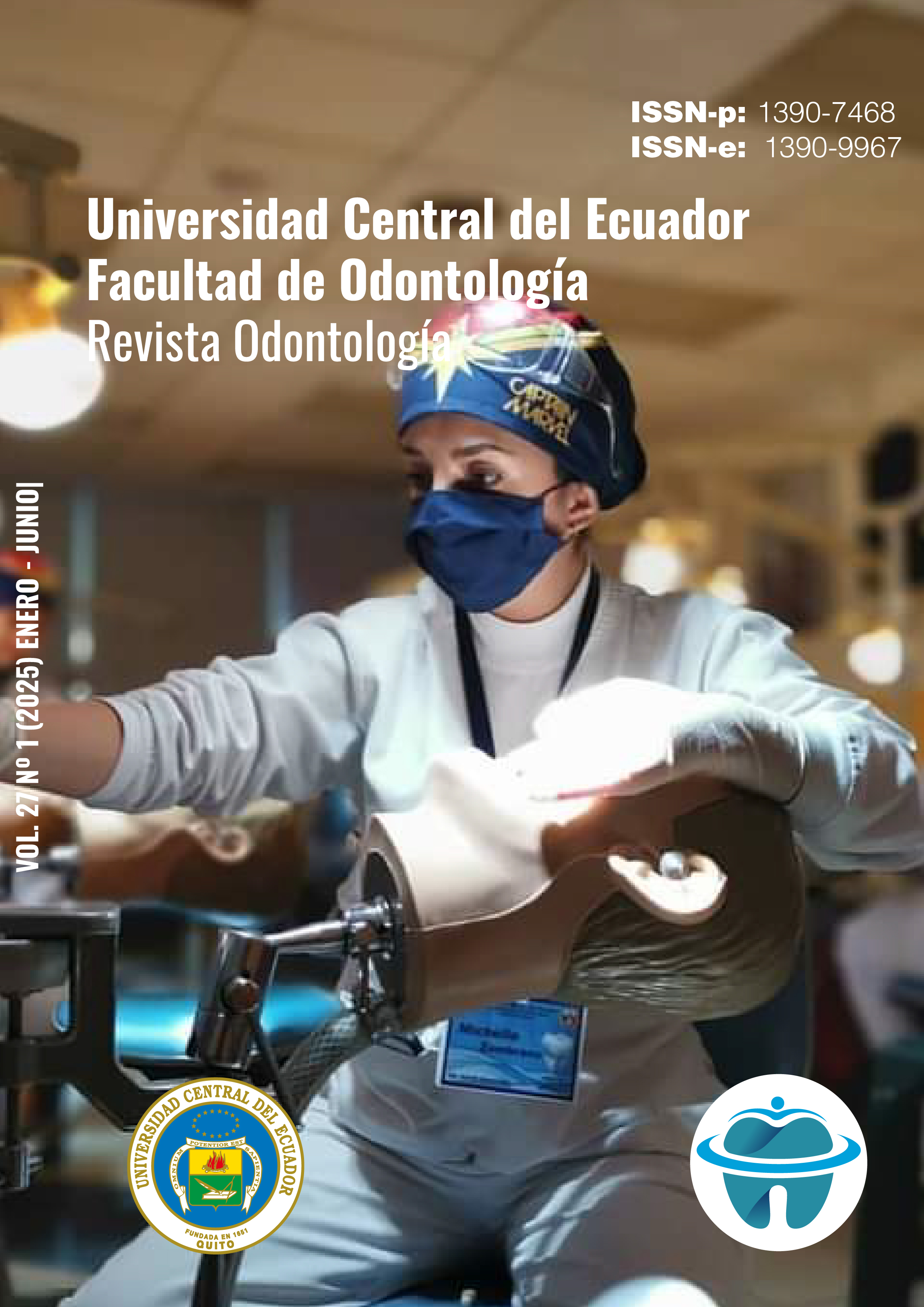Exodoncia quirúrgica de canino incluido en posición horizontal de mandíbula en región mentoniana. Caso Clínico
DOI:
https://doi.org/10.29166/odontologia.vol27.n1.2025-e7635Palabras clave:
Diente canino, - Cirugía bucal, Extracción dental, Mandíbula, Diente no erupcionadoResumen
Objetivos. –Exponer el caso clínico de una paciente femenina sometida a exodoncia quirúrgica conservadora y planificada del órgano dental 33 incluido en el hueso mandibular, destacando la técnica quirúrgica, los resultados obtenidos y la importancia de la planificación en la conservación de los tejidos. Materiales y métodos. -Esta investigación de tipo demostrativa presenta un caso clínico en el cual se puede identificar la posición heterotópica del canino incluido en la arcada dental y las estrategias terapéuticas de prevención temprana que se pueden aplicar dentro del plan de tratamiento, evaluando las patologías dentarias y complicaciones que puede generar la inclusión de este diente, en este caso se realiza la exodoncia quirúrgica del órgano dental 33. Resultados. – El tratamiento quirúrgico con un abordaje planificado nos permite realizar un tratamiento mínimamente traumático, devolviendo la funcionalidad dental y ayudando a la prevención de anomalías dentarias causadas por la mala posición del órgano dental incluido en el hueso mandibular entre el tercero y cuarto cuadrante, a nivel del tercio apical del incisivo lateral y el canino colateral. Conclusiones. - El caso clínico presentado demostró que la exodoncia quirúrgica fue la opción de tratamiento más adecuada para el canino retenido, debido a su posición horizontal, impactación y morfología. La evaluación y planificación cuidadosa realizada permitió minimizar riesgos y conservar los tejidos, logrando una extracción exitosa sin complicaciones.
Descargas
Citas
Gay Escoda C, Berini Aytés L. Tratado de cirugía bucal. 1a ed. Ergón; 2011.
Icochea AT, Lopez CW. Odontoma compuesto asociado a canino permanente inferior impactado [Tesis de pregrado]. Universidad Peruana Los Andes, Facultad de Ciencias de la Salud; 2022.
Mendoza M, Aguirre JD, Zhunio KA, Larrea C. Tratamiento interceptivo en pacientes con caninos retenidos en maxilar superior [Tesis de pregrado]. Universidad Mayor de San Andrés, Facultad de Odontología; 2022.
Díaz Palomino SY. Canino retenido en el maxilar superior: Investigación clínica y patológica [Tesis de pregrado]. Universidad Peruana Los Andes, Facultad de Ciencias de la Salud; 2020.
Ormaza CG, Lara LV, Jarrín MJ, Castro JA. Regeneración ósea con fibrina rica en plaquetas e injerto óseo autólogo post extracción de canino impactado. Reporte de caso. Rev KIRU. 2021;18(1):1-8. doi: 10.24265/kiru.2021.v18
Cushpa Pilco CX. Caracterización diagnóstica del tratamiento odontológico de adolescentes con caninos retenidos [Tesis de pregrado]. Universidad Nacional de Chimborazo, Facultad de Odontología; 2023.
Lazo YA, Soto A, Massón RM, Ferreiro A, Amaneiros O. Detección y tratamiento temprano de caninos superiores retenidos. Invest Medicoquir. 2021;13(1):1-22.
Alcazar V, Ulfohn A, García F, Bonini L, Orellano S, Morales A. Mandibular canine transmigration. Presentation of a case. Rev Fac Odontol (Valdivia). 2023;33(1):31-37. doi: 10.25014/revfacodont271.2023.33.1.31
Martinez M, Reyes M, Leon A. Rehabilitación estética y funcional de una paciente con caninos retenidos. En: OdontoSantiago 2023; 2024.
Valdivieso M, Ulloa A, Pineda D, Morales K. Canino retido con riesgo de fratura mandibular: Relato de un caso y revisión de la literatura. Res Soc Dev. 2024;13(7):37-41.
Falcón Guerrero E, Oliveira T, Palma V, Tonetto M. Manejo quirúrgico de la reabsorción radicular externa de incisivos ocasionada por un canino retenido. World J Dent. 2014;5(5):67-71.
Publicado
Cómo citar
Número
Sección
Licencia
Derechos de autor 2025 Jessica Jazmin Flores Ayala, Maria Viviana Mora Astorga

Esta obra está bajo una licencia internacional Creative Commons Atribución-NoComercial-SinDerivadas 4.0.


